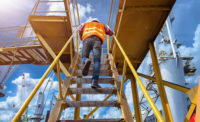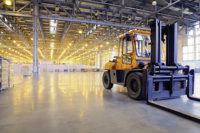The number of forklift-related OSHA citations was enough to make the list of 10 most cited violations in 2020. In 2019, forklift incidents accounted for 79 deaths and over 8,100 nonfatal injuries.
These powered industrial trucks are used daily across the United States. They make the impossible task of moving heavy equipment possible. When used correctly, they are great tools, but they can cause severe chaos on a worksite in the hands of untrained personnel.
I’ve seen the destruction that forklifts can cause on a worksite when not used properly. Early in my career, I saw an employee was headed towards a trailer for a piece of freight at a normal speed. An earlier rain that day caused the forklift to slide on the concrete floor when it hit a pool of water. When the forklift started to turn, the back end swung around, hitting a bollard. The employee flew out of the forklift, landed on the ground, and suffered several contusions. Why was the employee on the ground? You guessed it, no seat belt.
As a safety consultant, I’ve seen citations for lesser-known powered industrial truck regulations. Here are some of those regulations and some tips you can implement into your own powered industrial truck training program.
1910.178(l)(2)(iii): All operator training and evaluation shall be conducted by persons who have the knowledge, training, and experience to train powered industrial truck operators and evaluate their competence.
Every time I discuss forklift safety with a company, I receive the same questions regarding training, “Do we need to bring in an outside trainer?” “Do we need to send someone to a train-the-trainer course?”
Bringing in an outside trainer can help, but that person won’t fully understand how the powered industrial truck is being used at your site(s) or understand the work environment(s) where it is being used.
Train-the-trainer courses are great. They ensure that your onsite evaluator understands a proper forklift safety program. However, there is no requirement to attend an outside course.
The trainer conducting the onsite truck training and performance evaluation should be the person most familiar with the piece of equipment being operated at the site.
Also, each employee must be trained on the equipment they will be driving at that worksite, meaning if an employee took a training class elsewhere, it cannot transfer to your company as their training.
Assess staff readiness
1910.178(l)(1)(i): The employer shall ensure that each powered industrial truck operator is competent to operate a powered industrial truck safely, as demonstrated by the successful completion of the training and evaluation.
Several companies I have worked with have done well with a classroom version of training. I’ve also seen PowerPoint presentations, online compliance training courses, videos, quizzes, but the performance evaluation is the part of the training that is often forgotten.
Most potential operators can pass a written exam, but it’s entirely different when employees are behind the wheel and given control. Experience will be the key to a safe operator, so they need to practice. Powered industrial trucks don’t operate like automobiles.
Employees should have a few days to practice with the equipment under the trainer's supervision, and when confident, they should be evaluated.
Track staff training and performance
1910.178(l)(4)(iii): An evaluation of each powered industrial truck operator's performance shall be conducted at least once every three years.
A full-on training is not required every three years, but the performance evaluation needs to be conducted. It’s still best practice for anyone to get a full refresher, and it’s easier to track their completion of the training.
Get modification approval
1910.178(a)(4): Modifications and additions which affect capacity and safe operation shall not be performed by the customer or user without manufacturers prior written approval. Capacity, operation, and maintenance instruction plates, tags, or decals shall be changed accordingly.
Several companies have affixed attachments to a powered industrial truck:
- Drum movers
- Man lift cages
- Tow straps
- Trailer hitches
When an attachment modifies the equipment outside of the manufacturer’s intended use, then the company must obtain some written acknowledgment that the attachment can be used. Check the manufacturer’s manual for a section on modifications. If the manual has no reference to modifications or attachments, then the company should contact the manufacturer.
Forbid horseplay
1910.178(n)(9): Stunt driving and horseplay shall not be permitted.
Go to the internet and search “forklift fails,” and everything you see is a heavy citation in the eyes of a compliance officer:
- Forklift on two wheels
- Forklifts sliding
- Immediate stop with a load at the max-height
- People riding on the forks
- Two people on the same truck, which was only made for one occupant
- Forklifts raising forklifts
If you see any of this at your site, those operators need to be sent back to operator training immediately.
Implement pre-trip inspections
1910.178(p)(1): If at any time a powered industrial truck is found to be in need of repair, defective, or in any way unsafe, the truck shall be taken out of service until it has been restored to safe operating condition.
Pre-trip inspections prove to be worth their while. If a truck is found to have a mechanical defect which causes an incident, this could easily become a “Willful” citation with a heavy fine. The equipment should have a proper pre-trip inspection documented at the beginning of each shift when it is planned to be used.
Buckle up to stay safe
You might notice that I haven’t included a specific regulation on using a seat belt on a powered industrial truck. That’s because there isn’t one. But there is the general duty clause, and OSHA published an interpretation letter on this topic.
In my experience, OSHA will issue citations for employees not being properly restrained in a powered industrial truck. Wearing seatbelts can be a challenge, and if it’s one you are experiencing, I suggest researching some of the newer technologies being used. There are sensor devices that can be affixed to powered industrial trucks, which prevent the truck from starting unless the operator is properly buckled.
Powered industrial trucks help move commerce around the world much faster. There are some great operators out there who can build a perfect storage area for your heavier freight, but those operators won’t be around forever. The next generation out there is still inexperienced, which is why a well-rounded powered industrial truck safety program is essential. Give your operators the time to get experience and adjust to the equipment, or you may get that call no one wants to receive from some serious workplace mayhem.



